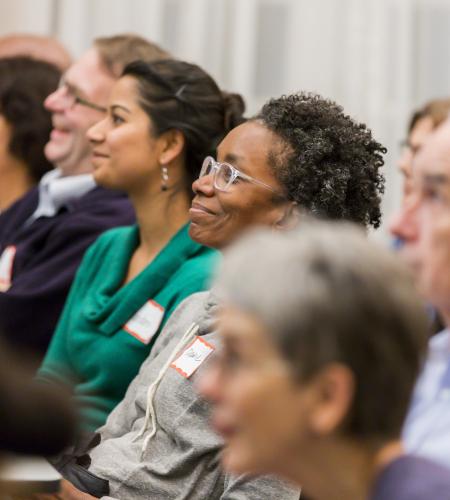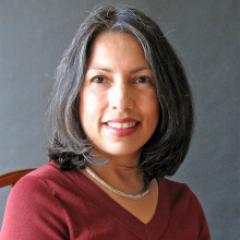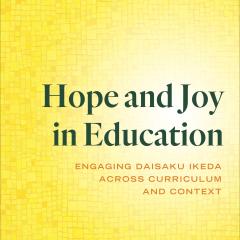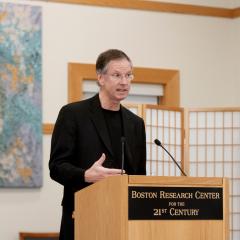The Ikeda Center’s newest book, Hope and Joy in Education: Engaging Daisaku Ikeda Across Curriculum and Context, launched in virtual but grand style on April 15, 2021. Nearly 300 attendees from 20 countries gathered on Zoom to hear editors Isabel Nuñez and Jason Goulah discuss their motivations and hopes for this groundbreaking multi-author volume, developed by the Ikeda Center and published by Teachers College Press. This article by Mitch Bogen shares highlights from the event. View a video of the full event here.
Panel Discussion: Hope and Joy in 2021
After welcoming remarks from Ikeda Center Program Manager Lillian I, Center Events and Publications Coordinator Anri Tanabe moderated a half-hour panel discussion with Nuñez and Goulah. She opened by asking them to discuss the genesis of the book. Speaking first, Nuñez observed that her vision for the book goes all the way back to her years as a first-grade teacher, when she found that “if we weren’t having fun, kids weren’t learning as much.” Today, she maintains this same focus on creating joy in her teaching and in her position as Director of the School of Education at Purdue University Fort Wayne. Given the pressures today’s educators face, this is an essential act, she said.
Goulah, who is director of the Institute for Daisaku Ikeda Studies in Education at DePaul University, recalled how, after meeting and talking with Isabel at several education conferences, their talk turned to the work of Mr. Ikeda. In response to her interest in developing her understanding, Jason suggested Isabel read The Wisdom of the Lotus Sutra (published by World Tribune Press and featuring Ikeda in dialogue with Katsuji Saito, Takanori Endo, and Haruo Suda), which “is six volumes and – classic Isabel – she just read it immediately.” Later, when Goulah asked her what she saw as the core idea or theme contained in it, “she said joy – joy comes through loudly and clearly for me,” a response that struck him as accurate and perceptive. Crucial to note here, added Goulah, is that for Ikeda, joy is both complex and intentional. In many ways, Hope and Joy in Education is an elaboration on and investigation of that core insight.
Beyond these personal motivations, Goulah and Nuñez said that the most fundamental reason was to help educators experience a revitalization of their educational commitments and practices, given the unbelievable range of obstacles and challenges today’s teachers and students face.
Next, Tanabe asked about how they went about selecting the roster of authors to invite as contributors. Nuñez recalled being at the Bergamo curriculum conference a while back and sitting in her room reflecting on the way many of the presenters communicated a visceral “emotional resonance.” These were the scholars that first came to mind to invite, those whose scholarship is “centered not just intellectually but also in the heart.” Moreover, she thought of those who, quite simply, “embody” hope and joy.
Goulah said that it was important that there be a mix of established and emerging scholars, a goal that was clearly achieved, with several doctoral candidates among the contributors. Goulah added that all the contributors have been forging “new ways of making meaning,” positioning them to offer new insights on Ikeda’s vision of education as a process of value creation and mutual growth. In turn, he thought to invite scholars whose own work he felt would be enriched by engagement with Ikeda’s core philosophy. Ultimately, more than 20 scholars agreed to contribute!
As a nice aside, Nuñez added that over the past several days she had been re-reading the book simply as a “reader and not as an editor,” and was impressed with the strength of the chapters and the insights that individual authors brought to the project. For example, she said she had been learning a lot from Melissa Bradford’s chapter on the careful planning that goes into conducting value-creating dialogue and was reminded by John Lupinacci’s chapter how wise it is to embrace our mutual dependency rather than seeing ourselves as “an island,” self-contained and not in need of others.
Tanabe’s next question was the pressing one of how educators can keep hope and joy alive after the painful, tumultuous year of 2020. Nuñez said that, as the person assigned to write the conclusion, this proved to be an agonizing question for her. Though the book was conceived and the great majority of the chapters written before the calamitous events of spring 2020, the timeline called for the conclusion to be composed that summer. Usually not one to suffer from writer’s block, Nuñez now found herself unsure of what she might say about hope and joy in education that wouldn’t sound like denial. Talking it over with the editorial team, she soon realized that one Buddhist teaching in particular showed the way forward, not just for the chapter but for her personally: the teaching of poison into medicine. As she understands it, this instructs “that the same substance can be destructive or beneficial depending on a lot of things,” but “mostly dependent on our perspective.” What this means to her now, is that in this time of social turmoil, we must exhibit “our willingness to learn and engage” with people and events around us. Without a doubt, she said, this teaching helped her in “a really hard time.”
Goulah said that the main thing he would add is that for Ikeda, hope and joy must always emerge from one’s inner self. If, on the one hand it sounds “uncompromising” to position hope and joy like this, “it’s incredibly empowering and powerful that you have within you this capacity to bring out from your interiority these kinds of perspectives on life, no matter what, even in the midst of horrible trauma.” In fact, said Goulah, his own chapter dealt with the counterintuitive Buddhist teaching that one can experience joy in death as surely as in life.
Q & A: Making a Choice for Student Happiness
The first question for the editors addressed a challenge familiar to all parents of school-age children over the course of the last year, which is how, during this time of Zoom and online learning, can “teachers best connect with students and bring joy back to the learning experience?” Responding first, Nuñez said her own daughter has been “Zooming into classes, and she doesn’t love it.” Nevertheless, the main thing to remember is that “relationship is the heart of teaching,” even in the virtual environment. This is not to say that things like learning standards aren’t important, she said. But, adding another dimension to her opening point, “students need to feel like their teachers know them to master the standards,” something that is true “virtually or when we all go back.”
Goulah built on Nuñez’s point by explaining how Ikeda views education as inherently a process of mutual growth. He said that for Ikeda, if the teacher is not growing and “transforming,” including internally, then the student will not be able to either. The other key for Ikeda is value creation, i.e., how can the teacher “create value where it does not exist”? It’s not “wishful thinking,” he said, to believe that truly transformative education can happen in virtual spaces, especially if the teacher remains focused, despite the inconveniences of the online environment, on treating “these young learners as individuals.”
The next attendee question was: what can educators do to foster not only hope and joy but happiness among learners? Nuñez said that teachers need to not just content themselves or restrict themselves to state learning standards. As director of a teacher preparation program, she said, she deals with the state standards every day, “and I don’t remember anywhere in any of those standards [them] talking about the learner joy.” Underscoring her core conviction, she added that you really can’t get students engaged with the core academic curriculum without some measure of happiness and joy in the classroom.
Goulah said that for Ikeda, happiness is not “hedonistic pleasure or nihilistic satisfaction,” but rather something that emerges from the capacity to make meaning no matter the circumstances. A powerful tool here, is for us to see ourselves as part of “the larger tapestry of life.” Specifically, said Goulah, teachers can help students develop this kind of happiness and engage in this kind of meaning making if they focus on the development of what Ikeda calls the three components of global citizenship: wisdom, courage, and compassion. These, coupled with an awareness of interdependence, he added, means a student becomes able to “expand the scope” of their life in an empowering way. Each of the authors in Hope and Joy go into detail on these points, he said, in “very specific ways from kindergarten, all the way up to higher education, and in a wide variety of disciplines.” So, he concluded, for true inspiration “read all the chapters in this great book,” and “don’t just take it from me!”
To conclude, Tanabe asked the editors if they had any more thoughts they wished to share. Nuñez responded with gratitude, saying “I’m honored and humbled by the number of people who are here and interested in this book.” She went on to say that she is the “luckiest” one of all, having “learned so much, and gained so much from the project.” She hoped that attendees might also benefit and “gain some hope and joy as well from the book.”
Goulah concurred, saying “it’s exactly the same for me,” expressing appreciation for the way Isabel “cares a lot about education and advocates for education and educators” and for how Teachers College Press “immediately saw the relevance of the work.” His biggest hope for the book, he said, is that if teachers and others are struggling, “maybe something in this book will inspire them to not give up on themselves or the students that they’re working with.” Ikeda’s perspective, Goulah concluded, is that “everything has a vista of possibility.” The truth for him, he said, is that if you are able to help a young person succeed in even the most difficult of circumstances, “it’s better than any paycheck.”
Conclusion: Gratitude is Prerequisite to Hope and Joy
Ikeda Center Executive Director Kevin Maher opened his concluding remarks by quoting the acknowledgments section of the book, which “Isabel and Jason begin by writing that ‘gratitude is integral, perhaps prerequisite, to hope and joy.’” In that spirit he first offered “sincere thanks” for all who attended the event, including “many friends – from near and far and representing many time zones – who joined us this evening.” Next, he extended his “deepest gratitude to Drs. Isabel Nuñez and Jason Goulah for leading us in tonight’s engaging dialogue as well as for the tremendous care and passion you put into the editing and development of this book.” Recalling the hundreds of emails and the many Zoom calls among Jay and Isabel and the Ikeda Center book development team, he said “it feels fitting that the book itself was developed through extensive dialogue.”
Then there are “the amazing chapter authors.” He noted that when Center staff and the editors worked on brainstorming potential contributors, they drew up a “dream list of scholars,” and “to our absolute delight, most of the scholars on our dream list confirmed that they would be happy to contribute.” Reading the book now, said Maher, he could see how each chapter contains “unique and important insights” into the fostering of hope and joy and also how “strongly they resonate with each other.”
He also extended gratitude to Teachers College Press, always “our top choice” to publish with, given their place of prominence and respect in education publishing. Thus, “we were thrilled” when they accepted the proposal. Since then, said Maher, they have been a “phenomenal partner to work with.” He added that “we’re particularly indebted to acquisitions editor Brian Ellerbeck who saw value in the project right from the start and has provided guidance and support throughout.”
Of the book, Maher said that “if the promise of reinvigorating hope and joy in teaching and learning seemed pressing prior to COVID-19, then it feels absolutely essential now.” Here, he quoted from Cynthia B. Dillard’s foreword: “It is a necessary text at a necessary time when, amidst the violence, global pandemics, enduring racism, and the often mean-spiritedness of our encounters with one another, we must pause to seriously consider the absolute power of joy, hope, and spirit in the work of teaching and learning.”
Finally, he offered thanks to Center founder Daisaku Ikeda, whose work and life inspired the book. It was a “deeply meaningful experience,” he said, for us to be able to explore his ideas through “the multiple perspectives that make up this book.” Above all, he said that he hopes that this book will encourage everyone “to reflect on the moments and places where hope and joy are alive for you.” With that, he left everyone with this brief poem that Mr. Ikeda composed to open the book:
A life lived always
With hope
Is the way of happiness
The way of value creation




